This post may contain affiliate links. If you click an affiliate link and make a purchase, I may earn a commission. Also, as an Amazon Associate, I earn from qualifying purchases.--
If you’re looking at what pressure your 20-inch bike tires should be, then there’s a simple answer and a more complex one. The simple first:
20-inch bike tires would generally use a PSI between 30 and 50. The exact optimal PSI would depend on the manufacturer’s suggestions, the terrain, and the type of riding you will be doing.
In this article, I’ll go over everything you need to know about bike tire pressure for your 20-inch bike, particularly the following factors:
Tire pressures exist to make sure your bike rolls smoothly and quickly while avoiding as many flats as possible.
If you have typical narrow road tires, they would be optimal at about 80 to 130 PSI. On the other hand, mountain tires require 25 to 35 PSI. Moreover, hybrid tires settle at a comfy in-between of 40 to 70 PSI.
However, with that being said, almost all tires would come with a recommended tire pressure or range. These exist to minimize wear but aren’t necessarily efficient.
Plus, there are a few rare cases where the recommended pressure is not indicated. As a rule of thumb, you should then pump your tire until it’s firm but slightly squeezable.
You can read on for more details on respective tire pressure for the various types of bicycles:
20-inch mountain bikes would be designed to fly over bumpy and loose terrain. So, if you keep tires with too much air, you’d experience too much bounce.
Hence, the ideal mountain bike tire pressure would lower pressures for more shock absorption and traction.
Due to this, the recommended pressure is around 30 to 50 PSI for most 20-inch mountain bikes. This is considered a good balance between an on-road tire pressure (approximately 50 PSI) and an off-road riding pressure (closer to 30 PSI).
As somewhat discussed earlier, tire pressures can have two substantial impacts on your bike’s performance. These include grip and rolling resistance. The following are details on each:
Rolling resistance is defined as the amount of friction between a surface and a tire. This friction increases with resistance in movement and increased contact with the ground.
So, if you have an underinflated tire, this causes too much contact with a surface. Therefore, in consequence, it’s too much rolling resistance.
Although, you may be surprised to know that an over-inflated tire would also have the same effect of increased rolling resistance.
This is because too much air results in your tire becoming too bouncy, rather than encouraging a smoother journey.
Grip levels are determined by how much contact a tire makes with a surface. It ensures that the tires conform to the route they’re rolling over.
And this grip level would increase with more contact.
As a result, if the tire is overinflated, it’d just bounce off the surface or roll on the central strip only.
30 to 50 PSI is the recommended tire pressure for a 20-inch mountain bike (depending on the type of cycling you intend to do on it)When it comes to tire pressures, nothing is really as simple as it seems. Though I’ve already indicated a few aspects to think about, there’s still a lot worth considering.
In consequence, the following are a few factors that influence the ideal tire pressure.
This isn’t a well-known fact, but the temperature does play a significant role in dealing with air pressure. In particular, physics explains that increasing temperature leads to higher pressures.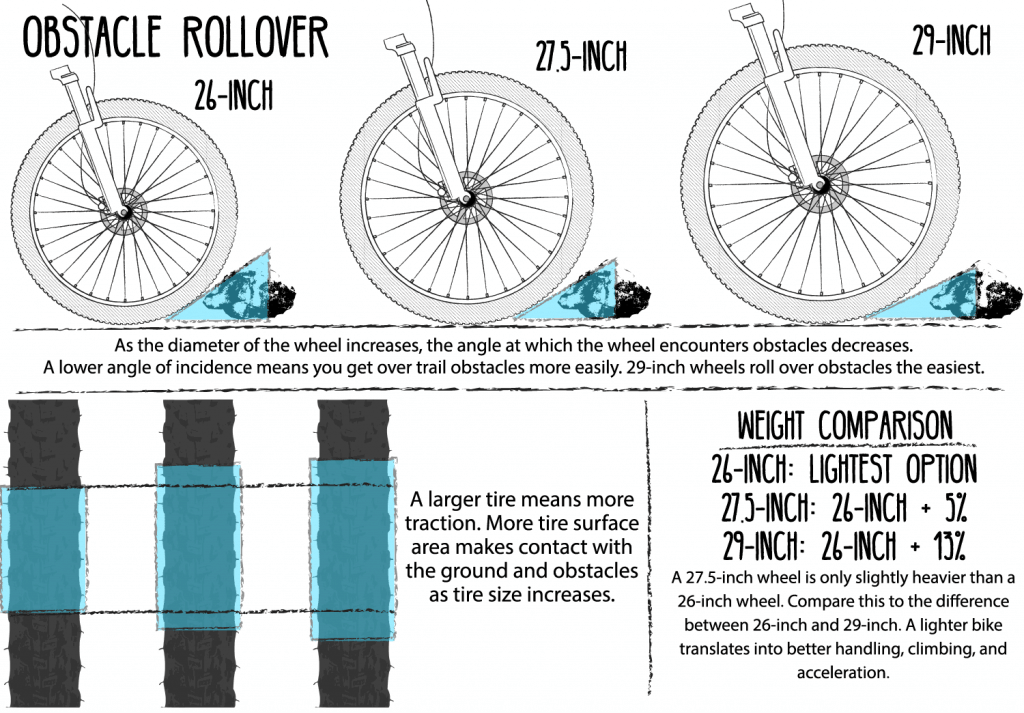
So, if you’re cruising along the beaches of Miami during summer, you’re bound to experience higher pressure than someone on a bike in Alaska during winter.
Likewise, rapid deceleration can generate friction which also increases the temperature. Fortunately, this has a quicker cool-off period, but it’s still something to be aware of.
You should know that more weight results in more pressure. So, if you’re planning on going on tour or cruising, you need to account for load.
For example, heavier riders would use a higher PSI than lighter riders for the same riding quality. In particular, a 200-pound load would need about 20 PSI more than a 160-pound load.
With that said, there isn’t really any rule to determine this PSI difference. Your only option is to experiment with what you have.
You can play around with the pressure to figure out what’s best for you. You should also keep in mind that rear tires tend to carry most of the load, so you should adjust accordingly.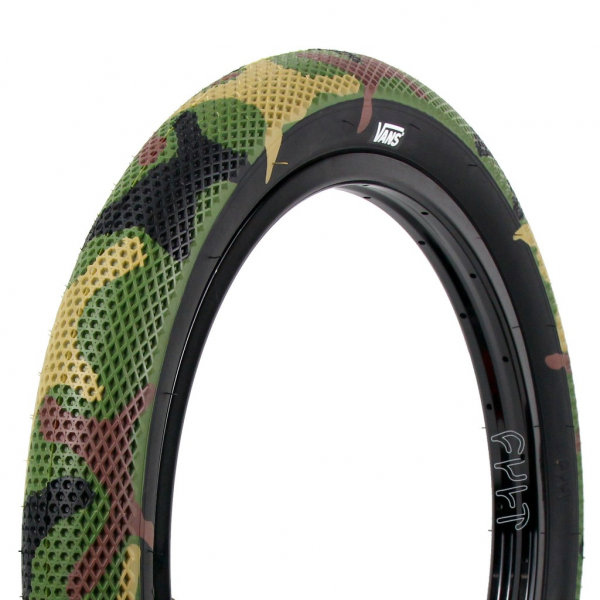
A common question by beginners is how often you should inflate your tires.
Well, for starters, this depends on your riding technique and style.
If you’re a merciless cyclist, you may need to pull out the pump every few days. Meanwhile, more gentle riders would inflate their tires only once a week or month.
If your bike is left in storage for months between use, you still may not need to inflate your tires as much. Air usually seeps out at an excruciatingly slow rate anyway.
So, the most ideal practice is to just check your tires before a journey. If they feel too soft, inflate them until they’re stiff again.
As crucial as tire pressure may be, it’s equally vital to find the right balance. You shouldn’t over-inflate because that increases the risk of blowing out a tube by pumping or sudden impact.
Likewise, you shouldn’t underinflate either, as the low pressure encourages pinch flats.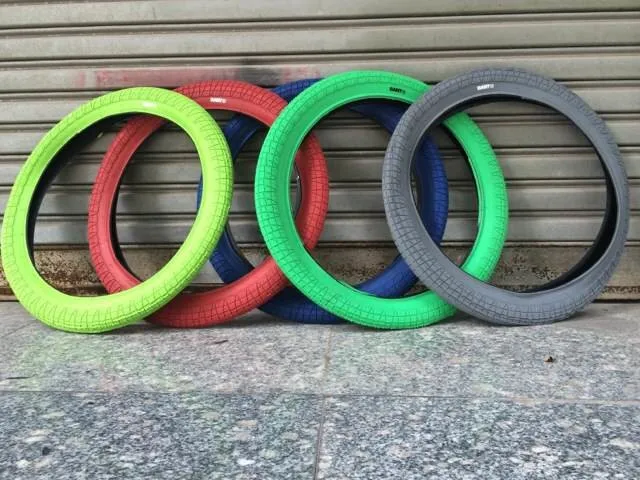 This occurs upon hitting a bump with underinflated tires.
This occurs upon hitting a bump with underinflated tires.
The tube gets squeezed by the rim and tire. This causes the tire to puncture and can even damage the rim.
In addition, flat tires would just slow you down and increase rolling resistance, so they’re not really the most effective.
Either over inflating or under inflating tires can cause different problems20-inch tires can be considered the same as any other tire. They would equally be affected by conditions, such as weight, temperature, under-inflation, riding frequency, and over-inflation.
So, the most reliable way to get the best tire pressure is to just check the number stamped onto the side of the tire. This would be the recommended tire pressure I mentioned earlier.
Regardless of size, shape, or type, it’s always crucial to have tires within this designed range. They’re the safest bet when dealing with unfamiliar tire types.
However, if the range was removed or unreadable, you’d have to do extra work.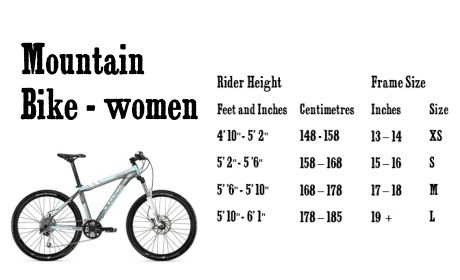
In these cases, I suggest going by trial and error. You can pump up your tires until they’re stiff enough to avoid pinch flats and maintain sidewall strength for stability and cornering.
There’s a logical limit for pressures in every tire type. And, when talking about 20-inch tires, I’d say it’s about 60 PSI with 80 PSI as a maximum limit.
Some people might consider 50 PSI as a “perfect” option. But this is just a matter of taste.
You may want an efficient, comfortable, or durable mountain biking style; different riding styles would just entail varying circumstances.
Wet conditions present unique adjustments to many riders. It isn’t safe to use standard air pressure, so cyclists usually drop their tire pressures for wet conditions.
With that being said, this isn’t really necessary, especially if you have the correct initial tire pressure.
But, if you decide to lower your tire pressure, I don’t recommend doing it by more than 2 PSI. Significant decreases in pressure might make your tire squirm, which results in instability on trails or roads.
Significant decreases in pressure might make your tire squirm, which results in instability on trails or roads.
Since we’re on the topic of tire pressure, it would be fitting to discuss the various types of pumps you might use.
There are two main bike pump options: hand pumps and floor pumps. The following are details on each.
If you’re an enthusiastic rider, willing to put in the extra effort while cycling, hand pumps should be your go-to choice.
Though they aren’t quick and need more work to function, they’re accessible for transport.
You can always have a hand pump on you. They are especially ideal for puncture repair kits during long-distance bike rides.
On the other hand, floor pumps are my recommendation. All of the pros use them, and they’re much easier to attach and pump.
You might even get gauges with some tires. These would eliminate any need to switch from a pump to a standalone gauge.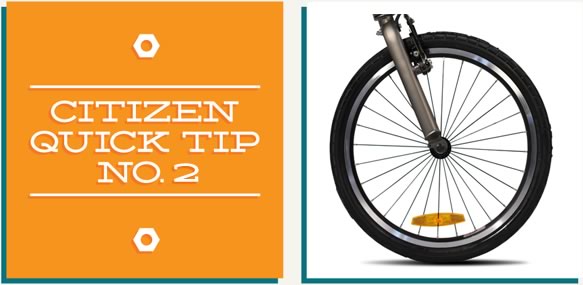 Plus, you wouldn’t have to guess whether your tire is at functioning pressure.
Plus, you wouldn’t have to guess whether your tire is at functioning pressure.
Yet, some experts are still a bit wary of floor pumps with gauges.
In most cases, this is because the accuracy of these gauges can sway and end up even being off by 10 PSI or more.
But, on the bright side, you can always consider the difference between consistent inaccuracies and adjust accordingly.
If you think these calculations are exhausting, you might be considering using an air compressor at your local gas station.
But, since these are meant for cars, they tend to be less accurate and overinflate your tires. So, if you’re looking toward becoming a serious rider, investing in a small pump can go a long way.
And, if you can’t get your hands on some eco-friendly option, you can opt for carbon dioxide inflates as an affordable alternative.
At the end of it all, tires would still leak air over time. Even with a proper set-up for butyl or tubeless tires, leaks would only be less common.
But, they won’t ever be permanently stopped. Whether we’re talking about a few PSI a week or dramatic changes overnight, air always seeps out at random times and due to various reasons.
For example, the depreciation rate could increase due to factors such as increased pressure because of lower temperatures outside.
And some models have even predicted a 2% decrease for every 10-degree drop in Fahrenheit.
So, if you really want to make sure you’re at the optimum riding pressure, I recommend checking your tire pressure as often as possible.
You could check it before every ride, or maybe you’d prefer once a week.
The crucial takeaway is that you should get into the habit of regular top-offs and check-ups, because, if you don’t, your tire pressure is probably going to be wrong for most rides.
20-inch bikes are relatively new on the market. So, many people haven’t really come up with the perfect range for every type of 20-inch tire bike.
As a result, my recommendation for finding the perfect pressure is to just play and experience with multiple pressures.
Depending on the road, type of bike, and load, you’d have to adjust accordingly. Road cyclists prefer rear-heavy pressure distributions.
However, some people make it work with a 50/50 front and rear distribution.
The bottom line is that tire pressures are unique and personal to every individual. As long as the pressure is within the recommended range of the tire, there isn’t really a perfect PSI for everyone.
If you really want to know what air pressure works for your 20-inch bike tire, you’d just have to go out and find that out on your own. Good luck and happy cycling!
Having the right PSI in your bike tires can make a world of difference. However, it would be an oversimplification to say that less air offers a more comfortable ride and more air makes you go faster.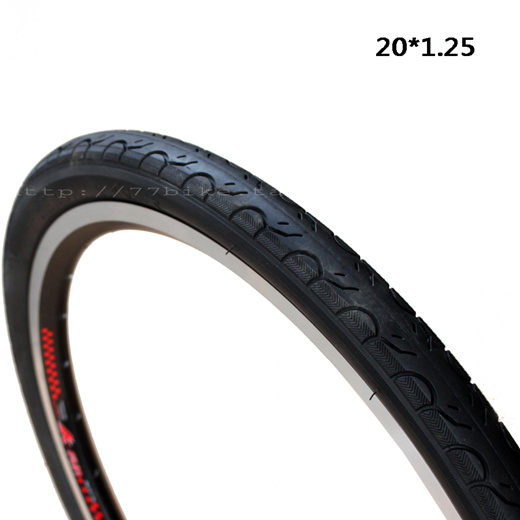 While this is true in many instances, the fact of the matter is that proper inflation for optimal performance depends on the individual rider and his or her bike.
While this is true in many instances, the fact of the matter is that proper inflation for optimal performance depends on the individual rider and his or her bike.
Every tire has a recommended psi printed on its side close to where it touches the rim. This is usually written as a range (for instance, "90 to 115 psi") since there are reasons why you'd want to be on the higher or lower end, which we'll get into shortly.
Basic rule of thumb if your tires happen to not indicate a recommended pressure: pump them up until they're firm but still slightly squeezable. Alternatively, there are generally-accepted ranges based on bike type:
| Bike tire type | PSI range |
| Kids' bike tires | 20–40 PSI |
| Narrow tires / road bikes | 80–130 PSI |
| Medium tires / hybrid bikes | 50–70 PSI |
| Thick tires / mountain bikes | 30 PSI (off-road) 50 PSI (on-road) |
Road bikes and tires are built for speed over smooth surfaces.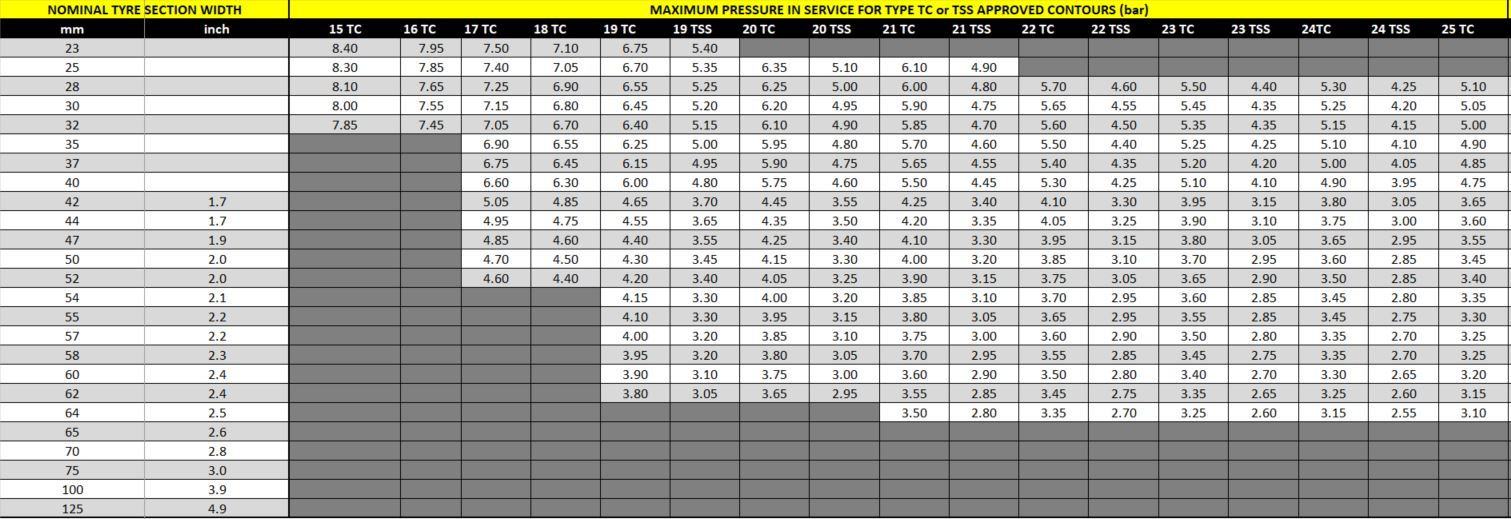 Higher air pressure lets them roll easier and faster. A typical range for these would be between 80 and 130 psi, although racers can sometimes go as high as 160 psi. Quick tip if you're caught inflating a road tire without a gauge and need to ballpark it: at 100 psi, a tire can barely be compressed with your thumb.
Higher air pressure lets them roll easier and faster. A typical range for these would be between 80 and 130 psi, although racers can sometimes go as high as 160 psi. Quick tip if you're caught inflating a road tire without a gauge and need to ballpark it: at 100 psi, a tire can barely be compressed with your thumb.
Unlike roadies, mountain bikes are flying over loose, bumpy terrain. Tires with too much air lead to too much bounce, making for a jolty ride. Lower pressure helps with shock absorption while also giving you more traction since more of the tire comes into contact with the ground. MTB manufacturers recommend between 30 and 50 psi on most of their bikes since this is a nice balance between on-road (closer to 50) and off-road (closer to 30) riding.
Hybrid bike tires require pressure levels between those of road and mountain bikes. This is usually in the 50 to 70 psi range. Kids' bikes have the lowest recommended inflation, typically 20 to 40 psi.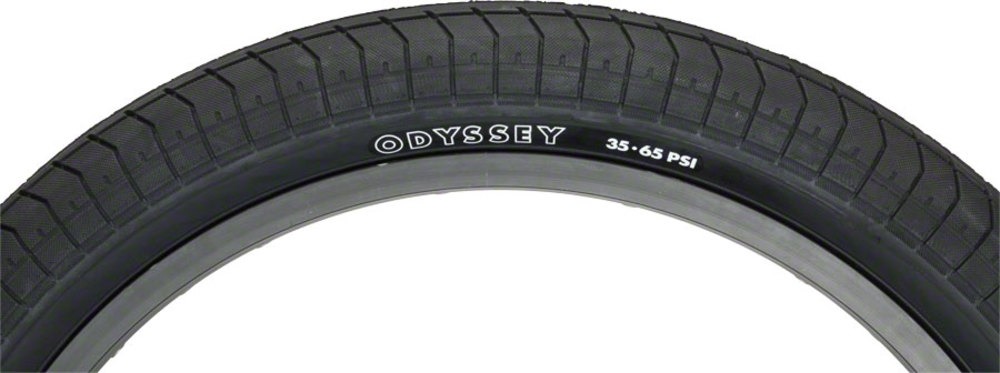 Keep in mind that these are called "recommendations" for a reason, though. A number of factors go into the inflation process beyond just your style of bike.
Keep in mind that these are called "recommendations" for a reason, though. A number of factors go into the inflation process beyond just your style of bike.
Which leads us to…
Because nothing in life is ever as simple as it should be, we've included a few more things to ponder when it comes to making sure everyone's tires are in good shape for their next ride.
As a general guideline, more weight = more pressure. Whether you're competing in the Tour de Whatever or shredding up the backcountry, heavier riders should use a higher psi than lighter ones to see the same performance in their tires. For perspective, someone weighing in at 200lbs will probably want to pump in around 20 more psi than someone who's 160. There's no real slide rule for this, so just play around with the pressure and see what feels best for you. Also keep in mind that rear tires tend to carry more weight than those in front, so adjust accordingly as necessary.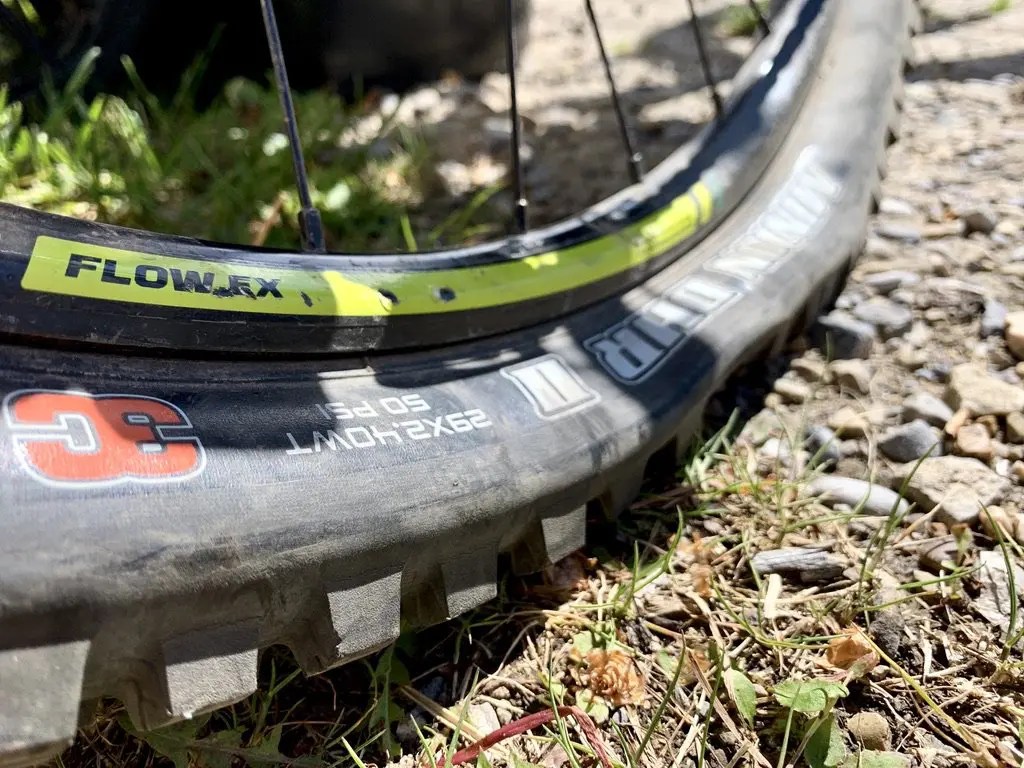
We know through physics that temperature affects air pressure. So, all else being equal, people biking in Miami in August are going to have higher pressure in their tires than people biking in Boston in January. In addition to weather, sustained deceleration using rim brakes generates friction that can increase temperatures inside the tube significantly. Fortunately, they also cool off relatively quickly, but it's something to keep an eye on during long descents. It may also be worth mentioning to your burgeoning roadster as he or she is learning the basics of hand braking.
In short, don't do either. If you overinflate, you run the risk of blowing the tube either while pumping or while riding due to sudden or constant impact. If underinflated, the low pressure could cause pinch flats. This occurs when the tube becomes squeezed between the rim and tire casing by hitting a bump with an underinflated wheel. Not only does this damage the tire, it can also hurt the rim. Plus, flat tires slow you down and make you pedal harder, which is just no fun.
Not only does this damage the tire, it can also hurt the rim. Plus, flat tires slow you down and make you pedal harder, which is just no fun.
"How often should I inflate my tires?" is a common question among many casual bikers. The answer depends on how often and how hard you ride. Some people break out the pump every few days, others once a week, and still others even less regularly than that. Even if you or your kids have left your wheels in the garage for months, air tends to seep out slowly, anyway. Therefore, as a bike-safety best practice, just like a car it's certainly never a bad idea to check your tires before each ride. Especially if it's been a while.
The pro's choice, floor pumps do a great job. They are easier to pump and attach, and will pump your tires up much quicker than a hand pump will. Some come with gauges, which eliminate 1) the need to switch back and forth between a pump and standalone gauge, or 2) if you're really lazy, outright guesswork.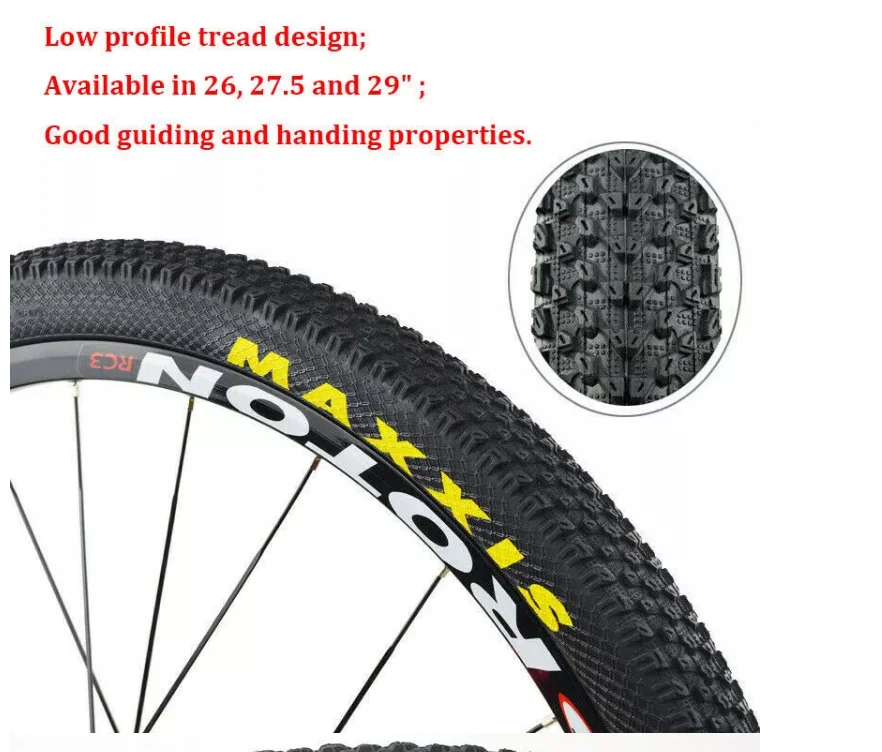
However, some expert cyclists are cautious of floor pumps with gauges, as the accuracy of the gauge can svary and may be off by as much as 10 PSI. On the plus side, if the gauge is consistent you can calculate the difference and adjust your target PSI to compensate.
It may be tempting to simply use the air compressor at your neighborhood Exxon, but these are less than accurate and can often overinflate your tires (it's a gas station, they're meant for cars). For serious riders whose circuits take them far from home, a small hand pump can help you change a flat on the fly. Carbon dioxide inflators accomplish the same thing if you're an air-in-the-can kind of guy.
Essential for any enthusiastic cyclist, hand pumps are harder work to fill the tire with, and aren't as quick. But they're transportable, so you always have your pump with you. It's simply foolish to embark on any long distance bike ride without your trusty hand pump and puncture repair kit.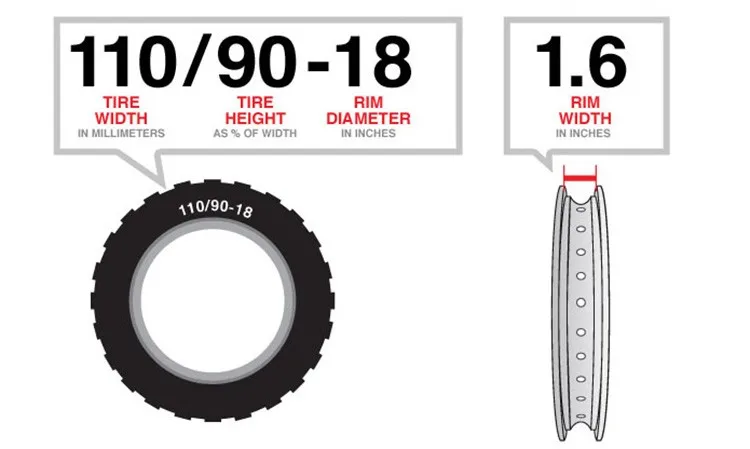
So there you go, we hope this quick guide to bike PSI pressure was useful. To recap: figure out what feels most comfortable based on your particular cycling style. Go with that. Keep an eye on your pressure, and check it before every ride. You'll get a feel for it over time. Like, literally.
When buying a bicycle for themselves, many do not even think about the fact that the convenience and comfort when riding it is achieved by properly selected tire pressure. The service life of the bicycle, the speed of riding, the degree of tire wear, safety, control of the two-wheeled friend depends on how the wheels are inflated.
Many cyclists believe that inflating the tires is only necessary for a good bike ride. However, flat tires have a wider area of contact with the road, which means that grip will be better, but it will be very difficult to accelerate to a speed of 30-35 km / h on such tires.
When inflating your tires, you should always consider the type of terrain or surface you will be driving on. If the walk is supposed to be on an asphalt road, the tire pressure of the bicycle should be close to the maximum allowable value. Elastic wheels on a flat surface will provide a smooth rolling and high speed of movement.
For cross-country riding with unpaved paths, it is better to set the tire pressure to medium tolerable, so that you can ride long distances in comfort and convenience. At high pressure, the grip of the wheel with the road will be minimal, respectively, all holes, pebbles, and bumps on the road will be sensitive.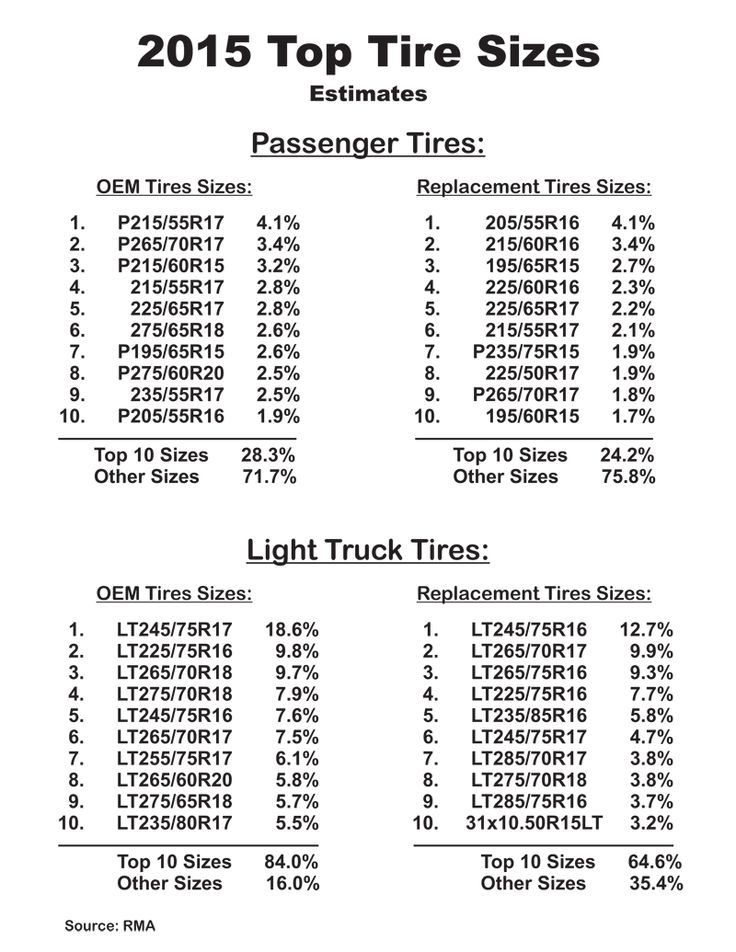 And with flat tires, the likelihood of damage to the wheel or puncture of the chamber increases.
And with flat tires, the likelihood of damage to the wheel or puncture of the chamber increases.
In order to protect yourself on the road, as well as to keep the bike or its individual parts intact, you need to know exactly the lower and upper limits of permissible values, to what pressure the bicycle wheels can be pumped.
Information about tire pressure gives you an advantage when cycling:
Forget the old "grandfather" way to check the wheel with finger pressure. No need to rely on tactile sensations, trying to feel with your hand the degree of rubber penetration on the tire. The air leaves the wheel gradually, through the pores in the rubber. Within 2-3 weeks, the pressure decreases by 0.1-0.2 atmospheres, but you cannot determine this with your fingers. The exact value at any time will help determine the pressure gauge that every cyclist should have in his arsenal. With its help, it is simple, with a minimum error, the level of pressure in bicycle tires is measured. A pump with a pressure gauge (floor or manual) will become an indispensable tool for cyclists.
No need to rely on tactile sensations, trying to feel with your hand the degree of rubber penetration on the tire. The air leaves the wheel gradually, through the pores in the rubber. Within 2-3 weeks, the pressure decreases by 0.1-0.2 atmospheres, but you cannot determine this with your fingers. The exact value at any time will help determine the pressure gauge that every cyclist should have in his arsenal. With its help, it is simple, with a minimum error, the level of pressure in bicycle tires is measured. A pump with a pressure gauge (floor or manual) will become an indispensable tool for cyclists.
There are three standard values in which bicycle tire pressure is measured.
kPa = 14.504 PSI
All these units are used to some extent - in different countries, by different manufacturers. For residents of Russia and the post-Soviet space, the change in bars is more familiar, since this unit is clearly associated with the pressure of the 1st Earth's atmosphere at ocean level.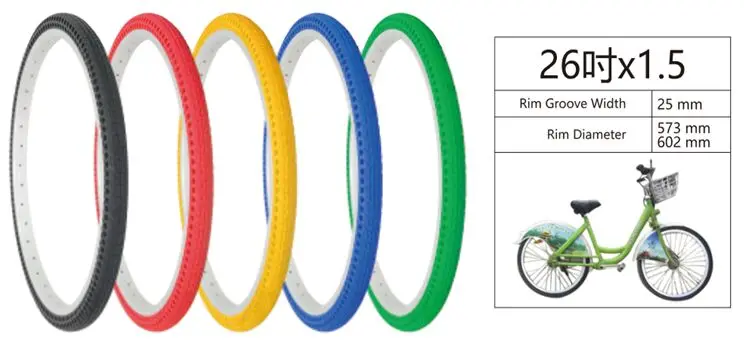 In America and Western Europe, a popular unit is PSI, as they actively use pounds and inches in measurements. Pascals are the least used unit of measurement, but the most modern. Some bicycle manufacturers write data on the wheels about the allowable pressures in all three systems.
In America and Western Europe, a popular unit is PSI, as they actively use pounds and inches in measurements. Pascals are the least used unit of measurement, but the most modern. Some bicycle manufacturers write data on the wheels about the allowable pressures in all three systems.
Manufacturers indicate on the sidewall of the tire how many atmospheres to pump the bicycle wheels. Specifies the range within which the owner of the "iron horse" determines the desired values, depending on the specific factors of riding his bike. Values in the range are labeled from min to max, in two or all three dimensions. Numbers up to 10 are atmospheres (or BAR), tens-hundreds are PSI, and six-digit values \u200b\u200band with the prefix “k” / kilo are Pascals.
When inflating a tire, you must strictly follow the manufacturer's recommendations and try not to go beyond both the minimum and maximum pressure levels indicated on the tire. Moreover, it is better to leave a small margin of 0.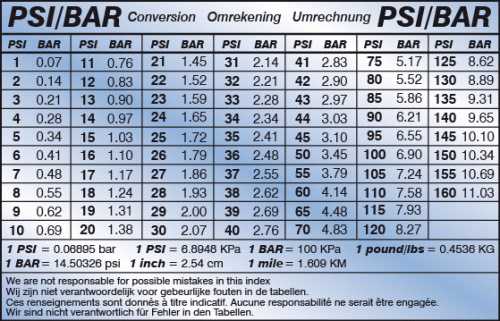 2-0.5 BAR, both in one direction and in the other, so that the tire does not burst.
2-0.5 BAR, both in one direction and in the other, so that the tire does not burst.
The pressure in the wheel is kept by the tire, not the tube, so there is no single standard for its value. There are several significant factors that determine how much you need to pump the wheels on a bicycle.
Tire type is determined by the surface of the track that the cyclist will predominantly ride on. Accordingly, the level of inflation of the bicycle wheel will be different. There is a direct dependence on the roughness of the tread and the width of the wheel - the more lugs and the wider the wheel, the lower the pressure should be. Empirically, cyclists quickly determine how many atmospheres should be in the tires of their bicycle
Many cyclists do not think about the fact that air temperature affects the pressure level in bicycle tires. From the course of school physics, we recall that when heated, bodies expand.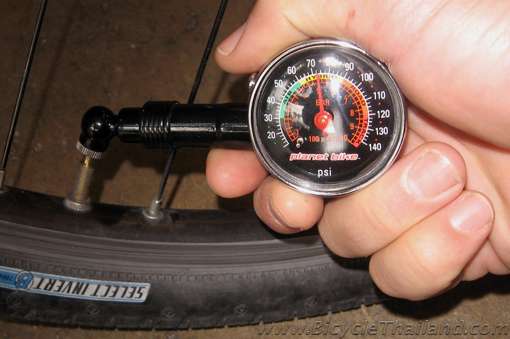 This means that in hot sunny weather, the pressure inside the air chamber will increase without additional pumping. Conversely, on cold winter days, a decrease in tire pressure is quickly felt due to low temperatures. So, when going for a bike ride in the cold season, the pressure indicators need to be adjusted a little higher than usual, and in the summer heat, let the air out a little. It is worth noting that when going on a bike ride, you should always take into account the weather conditions.
This means that in hot sunny weather, the pressure inside the air chamber will increase without additional pumping. Conversely, on cold winter days, a decrease in tire pressure is quickly felt due to low temperatures. So, when going for a bike ride in the cold season, the pressure indicators need to be adjusted a little higher than usual, and in the summer heat, let the air out a little. It is worth noting that when going on a bike ride, you should always take into account the weather conditions.
It is important to consider the load on the bike created by the weight of the rider, especially the fact that most of it is on the rear wheel. Therefore, the degree of its pumping should be slightly higher than the front, the optimal difference is 10%.
To calculate the optimal tire pressure for a bicycle, given the weight of its rider, you can use the table:
Rider weight (kg) Pressure (atmosphere) Pressure (PSI)
The nature, riding style and type of bicycle also affect tire pressure.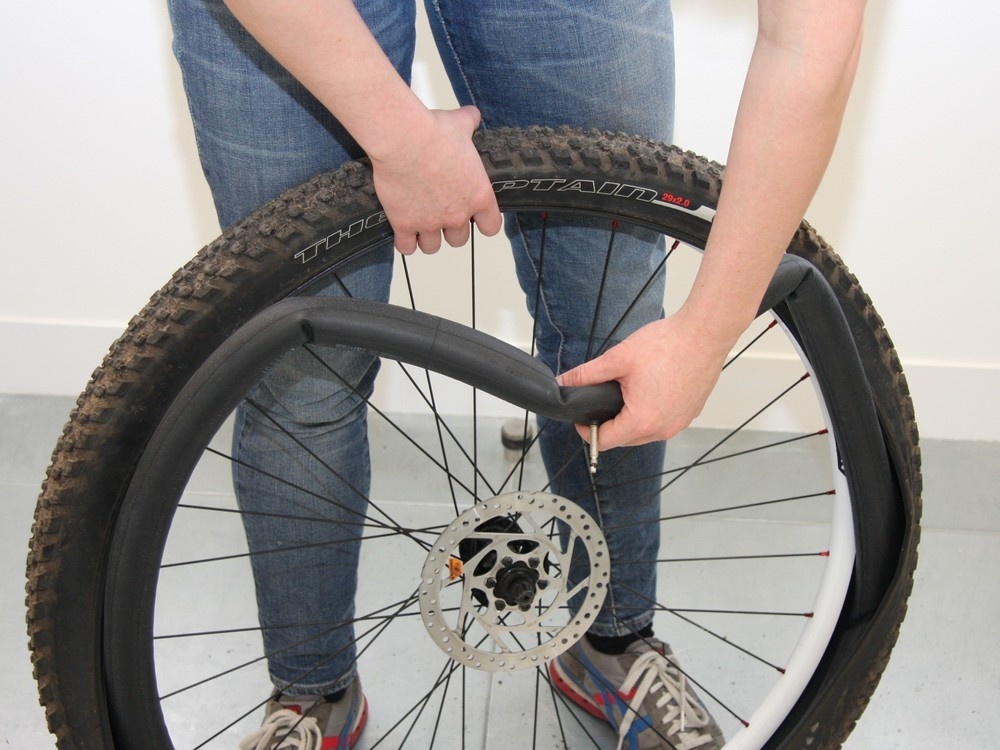 Buyers who prefer an active pastime often opt for mountain bikes with 26-inch wheels, which ride well both on city streets and in rough terrain.
Buyers who prefer an active pastime often opt for mountain bikes with 26-inch wheels, which ride well both on city streets and in rough terrain.
To understand to what pressure to inflate the wheels of a bicycle, it is necessary to take into account the features of both the bike itself and other, at first glance, weightless factors. For example, weaving threads on a tire, rim thickness, driving style. The likelihood of a tire coming off a wide rim is much less than a narrow rim, because a wider rim will hold the tire better than a thin one. Mountain biking already by its name suggests the presence of a difficult surface on the track, with possible obstacles and bumps. The driving style is more aggressive than on a smooth, calm trajectory, it obliges you to increase the tire pressure to a level slightly less than the upper limit.
The diameter of the wheel will also affect the selection of the optimal pressure value, since the larger it is, the higher the volume of air pumped will be.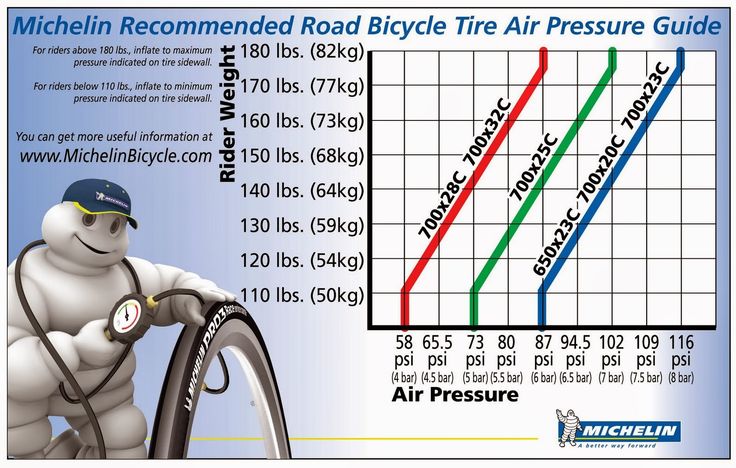 However, for mountain bikes it is not so important whether the wheel diameter is 26 or 29 inches, it is much more necessary to pay attention to the parameters of the rider's weight and the type of track.
However, for mountain bikes it is not so important whether the wheel diameter is 26 or 29 inches, it is much more necessary to pay attention to the parameters of the rider's weight and the type of track.
There are no hard and fast rules about how much you need to inflate the wheels on your bike. There is common sense, experience, practice. Manufacturers can recommend certain values, but only the owner himself will determine exactly which road he will ride, in what weather conditions he will drive, take into account his weight parameters or not. The decision, what pressure in the wheels will be ideal, is sure to be found.
Every cyclist is obliged to monitor the condition of his two-wheeled horse. It is from this that the envy of its service life and convenience when driving will be. When you go on your next trip, do not forget to measure the pressure in your tires. This procedure is mandatory, because it directly affects the comfort while driving.
This procedure is mandatory, because it directly affects the comfort while driving.
Oddly enough, first of all, the quality of cycling, especially on asphalt, depends on the pressure in the bicycle wheels. Under-inflated wheels easily break through and extinguish a large percentage of the efforts of the cyclist, while over-inflated ones can damage the tube and lead to its rapid wear. Accurate knowledge and experience of riding will help you find the golden mean.
Many people are accustomed to checking tire pressure using the old-fashioned method with their fingers. However, this method is very inaccurate, and the concept of a “well-inflated wheel” for each cyclist can be very different. That is why it is always better to have a pressure gauge on hand in order to accurately determine tire pressure.
Its cost is quite low, so everyone can afford such an acquisition.
Contents
In fact, the optimal pressure in the tires of a bicycle is a purely individual parameter that each biker varies within certain limits for himself: according to his riding style, according to the planned track and current level of training.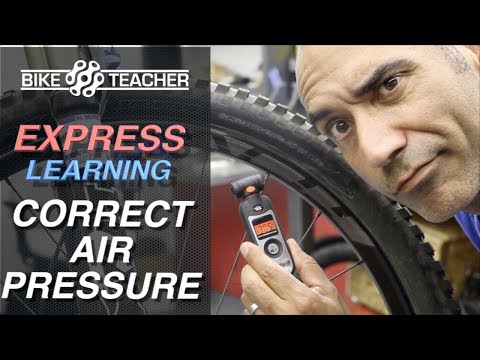 Limits are set by technological restrictions, which we will consider further.
Limits are set by technological restrictions, which we will consider further.
Here are the main factors to consider when choosing the level of inflation:
Considering all the pluses and minuses, one recommendation can be made: the wheels should be inflated enough to provide good traction and not damage the tube. To do this, there are standards for what pressure is considered acceptable. We will consider them further.
If the wheels are overinflated, the bike will have a good roll, but the tire will not absorb at all on uneven surfaces.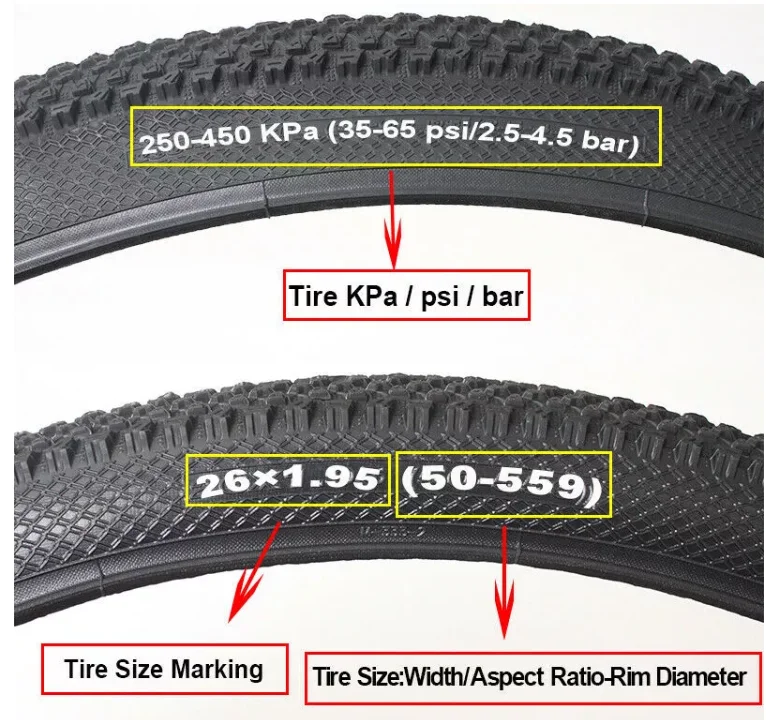 All difficult sections will be much harder, since the contact patch of the tire with the ground will have a minimum area, and you will be skidded when cornering. Needless to say, when cycling in winter, the situation is aggravated by slippery surfaces. In addition, pumping can cause the wheel to explode. Old Soviet cameras are especially susceptible to this, the material of which is already turning into dust from old age. The tire breaks from excessive pressure not immediately, but for example on a hill, where a pebble falls under the wheel. This situation is dangerous because the tire is sometimes literally torn off the wheel.
All difficult sections will be much harder, since the contact patch of the tire with the ground will have a minimum area, and you will be skidded when cornering. Needless to say, when cycling in winter, the situation is aggravated by slippery surfaces. In addition, pumping can cause the wheel to explode. Old Soviet cameras are especially susceptible to this, the material of which is already turning into dust from old age. The tire breaks from excessive pressure not immediately, but for example on a hill, where a pebble falls under the wheel. This situation is dangerous because the tire is sometimes literally torn off the wheel.
The air pressure in the tires of a bicycle also affects the "piercing" of the wheel. Pumped rubber easily collects all the carnations and glass on the road.
If the tires are flat, the situation is no better than if the tires are inflated. The tire does not fit snugly on the rim, may come off the wheel, and when driving onto a curb, a puncture may form (the so-called snake bite). The roll of the bike decreases and pedaling requires an increasing amount of force. However, when choosing between an over-inflated tire and an under-inflated one, it is better to opt for an under-inflated tire. But we must not forget about reasonable limits. If the tire drags like a rag, then you clearly made a mistake with the pressure.
The roll of the bike decreases and pedaling requires an increasing amount of force. However, when choosing between an over-inflated tire and an under-inflated one, it is better to opt for an under-inflated tire. But we must not forget about reasonable limits. If the tire drags like a rag, then you clearly made a mistake with the pressure.
The secret of the right choice is very simple: just look at the tire being inflated. Next to the information about the tire size, there will also be information about the allowable pressure range in the chamber.
Why is this information not printed on the camera itself? Because in it the only point that is subjected to real load is the nipple, and its mechanism is very reliable. Otherwise, the normal pressure, which increases by an order of magnitude with fast skating, is taken by the tire, and how much it will be squeezed is the main limitation.
So, at too low a pressure, the tire will break closer to the rim, bite the chamber, leading to breakdown, and at high pressure, it may simply burst on one of the bumps or when driving on hot asphalt.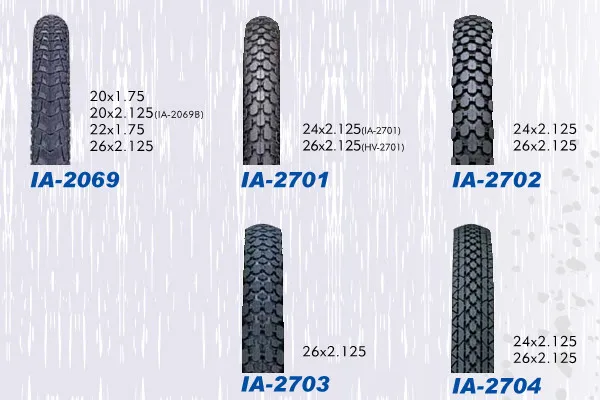
Since many tire manufacturers focus on the American market, the most common designation is Psi. In English sources, it is usually simplified to “pound”, or pound, that is, when they say that the pressure is 2 pounds, they mean exactly Psi. This unit of measure is obsolete, used only in the USA, but, as they say, "more alive than all living things."
Intelligent pressure sensor data on smartphone screen
Bars are also obsolete units of measurement, but are actively supported in Russia and many other countries, incl. European. This unit of measurement is actively used, as it echoes the “atmosphere”, which is quite convenient for measurements.
Pascal is the only metrically correct unit from the list, but is rarely used in bicycle notation.
The ratio between all units is as follows: 1 Bar = 100,000 Pa = 14.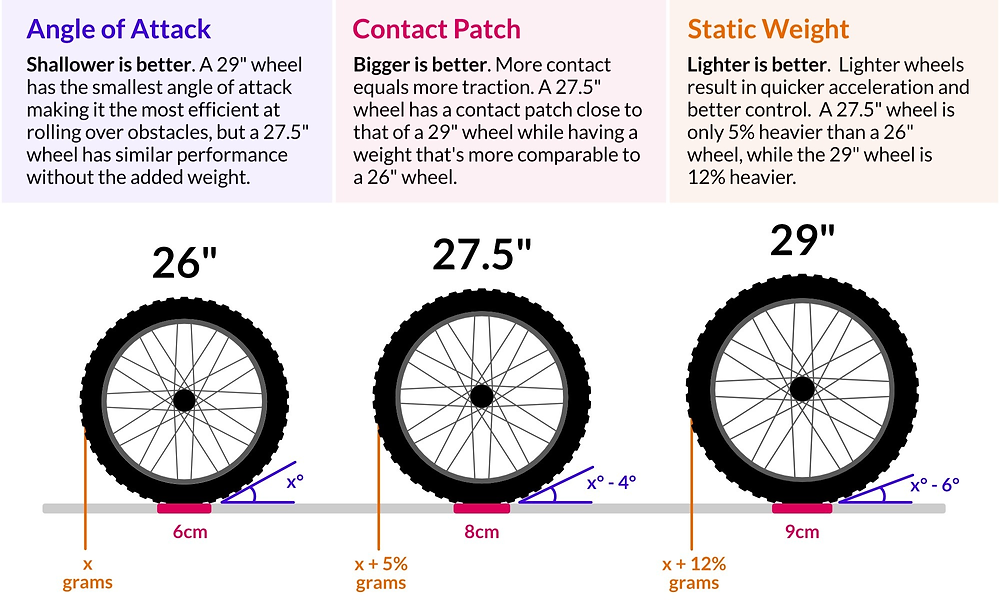 504 Psi.
504 Psi.
What do they write on tires? For example, (2.38-4.0) is clearly atmospheres, or BAR, and (95-135) is Psi. If the number has more than 3 digits or the prefix "k" (kilo), we are talking about metric Pascal. Most often, the desired value is located under the size designation and is duplicated in BAR and Psi as a range, clearly indicating to what pressure you can pump.
Actually, the manufacturer indicates the range within which the tire can function, further - the freedom of the cyclist.
Manufacturers indicate the recommended parameters on the side of the tire. Usually they are in the range of 35 - 60 psi (2.38 - 4.08 atmospheres). But still, this is a parameter that is selected purely individually. Therefore, there are a number of recommendations that are considered common to all people.
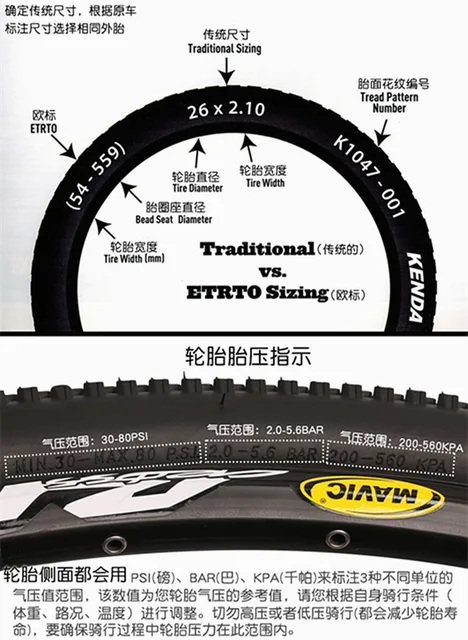
Important! With poorly inflated bicycle tires, the tire will move towards the rim, wringing the chamber. This will deform the wheel.
When the cyclist is training on relatively smooth asphalt roads, country and forest dirt roads and paths. For this style of riding, I prefer to inflate the wheels to 3.5-4 atmospheres. Such a high value of bar allows you to achieve good speed characteristics, high rolling, but when it hits bumps and stones, the fifth point immediately feels all the bumps in the road surface.
For those who like pleasure riding at low speed on smooth park roads, 2.5-3 atmospheres will be enough. On the Internet, you can often find recommendations to pump 2-2.5 bar into the wheels, this is justified only for tires at least 2 inches wide and when driving on rough terrain or poor coverage. Low pressure increases traction and comfort, but reduces rolling on smooth pavement. Under no circumstances should you ride at a pressure of less than 2 atmospheres.
Low pressure increases traction and comfort, but reduces rolling on smooth pavement. Under no circumstances should you ride at a pressure of less than 2 atmospheres.
The choice of terrain on which you prefer to ride obliges you to choose a certain type of tire, but in general, if you have a universal tread, you can make your ride comfortable on a particular type of road surface by changing the amount of wheel atmospheres. The figures below are based on a standard 2-2.1″ tire.
For gravel, mud, grass, sandy surfaces, it is better to inflate up to 2.5 atmospheres, which increases the adhesion of the tread to the ground and allows the wheel to smooth out all the unevenness of the road surface quite well.
For smooth asphalt roads, feel free to use a pressure of 3 bar or more. However, there is one thing here. If you have a fairly bald tread (wheels with a weak relief or slicks), and you drive at high speed on wet or even wet asphalt, then you risk slipping (flying out) on a turn.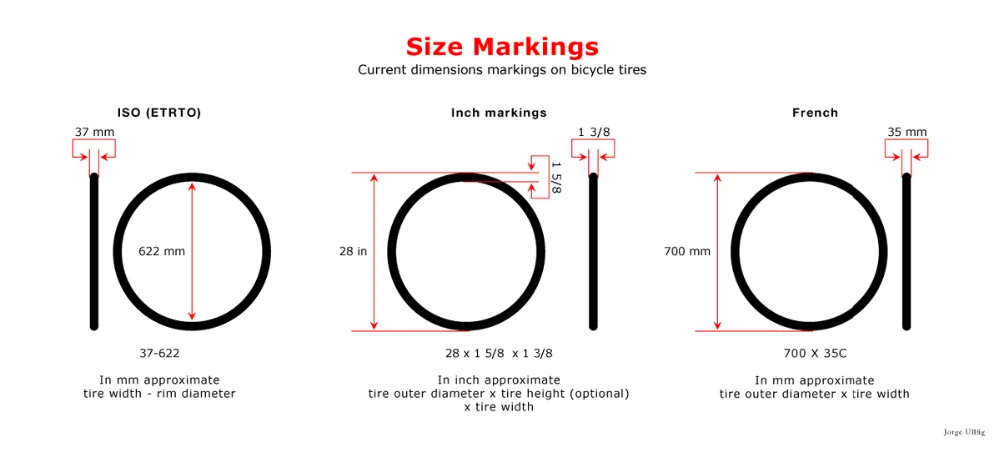 If it rains on the road, just slow down or deflate the tires slightly.
If it rains on the road, just slow down or deflate the tires slightly.
This article describes the most acceptable criteria for choosing tire pressure, but since each person independently selects the most convenient pressure values, I advise you, first of all, to experiment when mastering a bicycle.
The bicycle inner tube requires maintenance and pumping very often. Even on the most “hardy” city and mountain bikes, it is necessary to check and pump up the chamber once every 2-3 weeks, since air leaks not only through the nipple, but simply through the rubber. The high pressure "helps" the air molecules to find their way through the insufficiently dense chamber.
"City" or, simply, budget bikes, it is enough to inflate once every 2-4 weeks, mountain bikes - at least once every two weeks, road bikes - once a week, and road and sports bikes - before each trip.
Therefore, the pump is not only an emergency accessory, which is used only when a punctured tire is changed, but also a necessary part of preparation for departure. Active cyclists should consider purchasing two pumps:
Active cyclists should consider purchasing two pumps:
By the way, the place of a stationary pump is perfectly occupied by an ordinary car pump. It is also suitable for bicycles, it shows exactly how many atmospheres are inflated, and does not take up extra space. Some people prefer to pump up on "professional" pumps at gas stations, but not having their own professional tool can play a bad joke in case of an unexpected situation or when deviating from the standard route.
Here are some tables that will help you navigate in difficult situations, namely:
Mountain bike table: